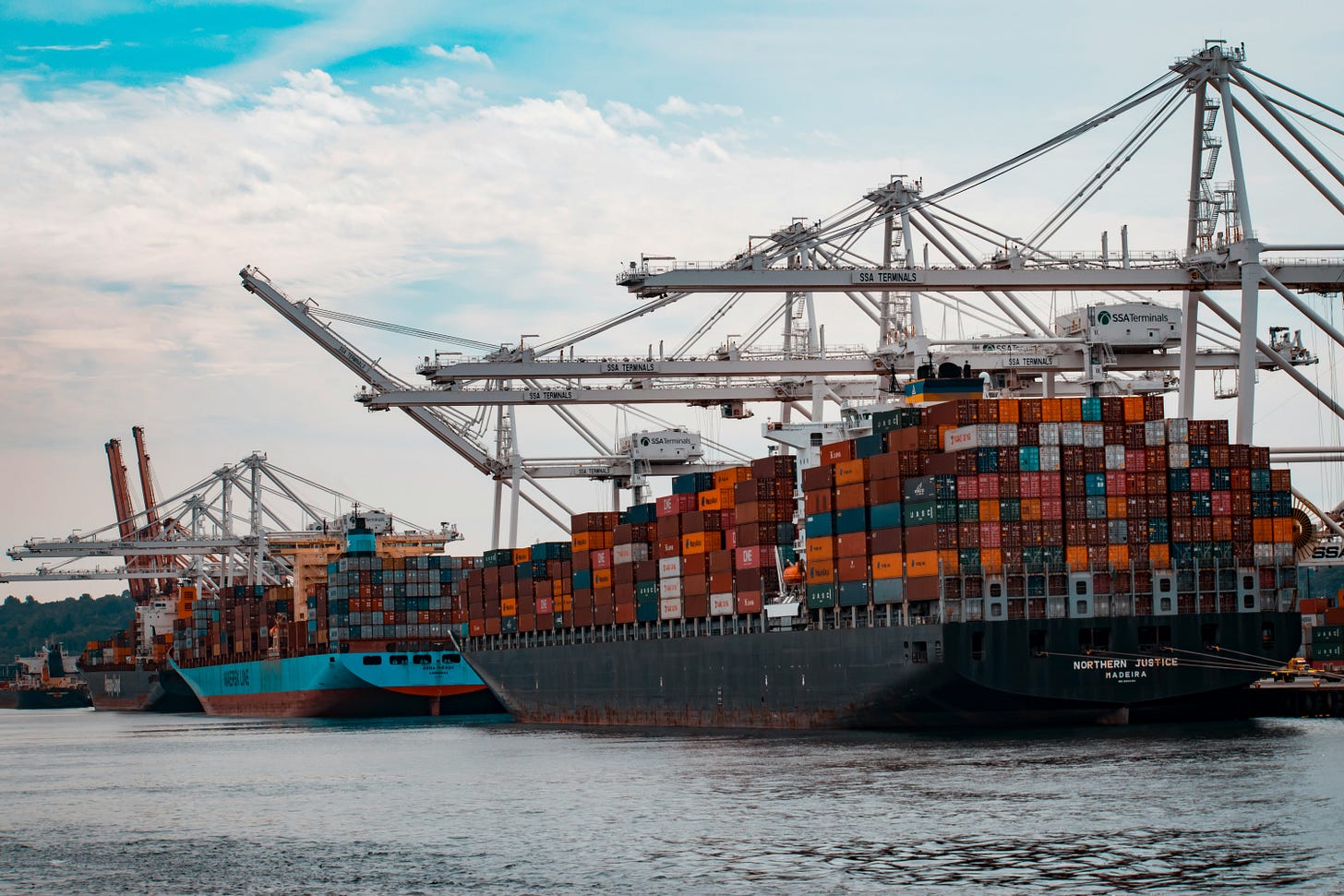(I visited the Port of Savannah once. I’m always amazed at how big these ships are.)
Last time, we looked at how supply shocks after the oil embargo and Hurricane Katrina affected prices. The oil embargoes hit everyone, while Katrina mainly caused problems for the southern states. This week we’ll look at the supply shocks following the COVID-19 pandemic, including:
· Work stoppage from illness and lockdowns
· Worker disgruntlement in the hospitality and trucking businesses
· Ports at near capacity on both coasts
· Supply disruptions as a result of the war in Ukraine
· Zero-COVID policies in China
The effect of COVID-19 and the subsequent lockdowns were immediate. Production in the economy plummeted as the US enacted lockdowns. Real GDP in the first quarter of 2020 fell 28 percent, the largest drop in history. The unemployment rate rose to 14.8 percent. The percent of small businesses that closed was up to 29.7 percent in 2020. Historically, about 13 percent of small businesses fail a year.
Shipping
At the same time, supply fell dramatically. Akin to the impact of the oil reduction program of OPEC in the 1970s, global shipping almost stopped. There were log jams at ports, as dock workers got sick and were concerned about returning to work. Concerns about COVID curtailed shipping among Canada, Mexico, and the US.
Within the US, goods couldn’t get from the ports to buyers further inland. In September 2021, at the Ports of Los Angeles and Long Beach, 62 ships were moored, six times the usual number. The ports in New York and New Jersey were nearing capacity too.
Remember how we couldn’t find toilet paper in March and April of 2020? On April 19, in 2020, almost half of the grocery stores in the US reported that toilet paper was out of stock. We ran out of other goods we needed as shoppers panicked, and retail demand forecasts failed. Supplies ran short on masks and flour, as hoarding disrupted the normal demand for goods. Meat at processing plants had to be destroyed because employees caught COVID, so we ran low on bacon, hamburger, and chicken.
Labor
After the initial lockdowns, it was hard to get employees back to work. Short-haul and long-haul truck drivers, dock workers at ports, and retail store and restaurant workers became ill. They had concerns about the safety of returning to work. Wages across these industries rose to combat the rising concern over working conditions and pay.
The labor market shifted too. Over 50 million wage earners left their jobs to find other jobs with higher pay, continuing a trend that started after the recession of 2007-2009. During the pandemic, many employees decided not to return to their jobs to look for new opportunities. Some returned to college or sought certifications to explore new career paths. The stimulus checks in 2020 and 2021 helped these people pay for classes.
In the US, the shift in the labor market hit us three ways: factory and store closures when staff got sick, slow in-person service, and supply-chain snarls as ports backed up. These factors led to inflation as wages and costs of materials rose. In addition, manufacturing and port closures reduced the availability of goods for consumers and producers, increasing prices. Demand rebounded in 2021, buoyed by stimulus packages from the Trump and Biden administrations, sending prices even higher.
Rising wages and materials costs also caused firms to shut down their business. This further reduced the supply of goods and services. Fewer businesses means less competition, helping cement those sticky prices you’re seeing at the grocery store. Some industries were already concentrated. Look at the back of soaps, detergents, bacon, and other prepackaged foods to see the number of different organizations that make these goods, and you’ll see what I mean. [1]
Climate Change
In addition, droughts caused problems in the midwest, disrupting the supply of grains. Wildfires in California and other climate changes also interrupted the flow of goods and services. Farmers switched to used tractors, revving those prices up. Companies like John Deere couldn’t get factory workers and materials to make new tractors.
Exports
Export-driven economies, like Mexico, Malaysia and China, were hard hit by the pandemic, since they couldn’t get goods out. China’s zero-COVID policy meant the delivery of goods and materials to other countries was unpredictable. Malaysia was hit hard by the delta variant, shutting down packing and quality control operations for microprocessors. [2]
On February 24, 2022, Russia invaded Ukraine. Fears of oil supplies being disrupted caused a panic at the pump. Average gasoline prices in the US jumped from about $3.80 to $5 a gallon by June. In other parts of the world trade from Ukraine became harder and grain shortages were common.
Labor Pool
By the time the pandemic was over more than a million Americans had lost their lives. Worldwide, over seven million people died. [4] While most of the victims were elderly and at-risk, some were part of the labor market that runs our dynamic functioning economy.
Closed immigration also reduced the available labor pool. As jobs openings ballooned, the developing skills mismatch between job holders and job seekers and job requirements, apparent for many years, became a crisis. [3] All of these factors caused supply to fall, sending prices spiraling.
I’ll spend more time on this skills mismatch and the so-called Great Resignation in a future post. (Nikki: Add to to-do list: This and any other posts I’ve promised to do.)
Thank you so much for taking the time to read. Comments and questions always welcome.
Nikki
[1]In Wouldn’t We Just Feel So Much Better, I looked into concentration in the cat food business.
[2] I looked into this in The Great Car Switcheroo.
[3] Some of the crisis resulted from a problem labor economists and human resources professionals called “looking for purple squirrels.” Managers inflated job requirements attempting to find the perfect person for the job, describing skills well beyond those necessary or available.





